How do artists use
afro-surrealism
to explore the state of being othered?
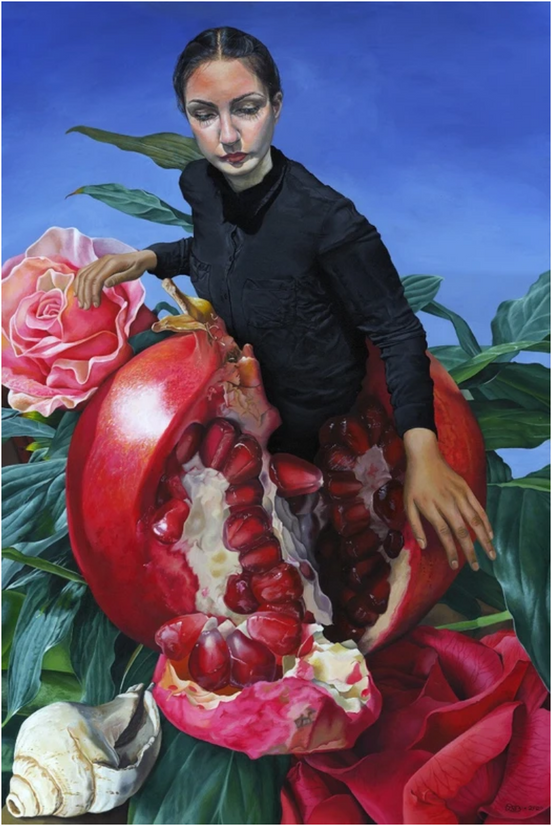
"Origin Story," Keerat Kaur
definition
afrosurrealism
The word afrosurrealism comes from adjoining the prefix "afro-" to "surrealism," which comes from adjoining the prefix "sur-" to "realism."
Realism refers to the 19th-century artistic movement characterized by subjects from everyday life represented in a naturalistic or photographic style. (1)
Surrealism is heightened realism. The term refers to the 20th-century avant-garde artistic movement known for its exploration of the unconscious mind. (2)
Compared to realism and surrealism, there's less clear consensus as to how afrosurrealism can (or should) be described.
Etymology offers a basic definition: if "surrealism" is heightened realism and "afro-" refers to something that is Black or African, then "afrosurrealism" is Black heightened realism.
To begin understanding what afrosurrealist art feels like, watch the short film below:
The "History" and "Philosophy" sections of this website explore some of the different ways afrosurrealism has been defined and described by various people over time.
History
terminology
1974 - Amiri Baraka coins the term "Afro-Surreal Expressionism" to describe the work of Henry Dumas. For Baraka, the use of contradictions to express truth characterize the genre. (3)
"Dumas's power lay in his skill at creating an entirely different world organically connected to this one. The stories are fables; a mythological presence pervades. They are morality tales, magical, resonating dream emotions and images; shifting ambiguous terror, mystery, implied revelation. But they are also stories of real life, now or whenever, constructed in weirdness and poetry in which the contemporaneity of essential themes is clear."
2009 - D. Scot Miller shortens "Afro-Surreal Expressionism" (with Baraka's permission) in the "Afrosurreal Manifesto." Miller clarifies who the term refers to, writing that "the root for 'Afro-' can be found in 'Afro-Asiatic,' meaning a shared language between black, brown and Asian peoples of the world." (4)
“Afro-Futurism is a diaspora intellectual and artistic movement that turns to science, technology, and science fiction to speculate on black possibilities in the future. Afro-Surrealism is about the present. There is no need for tomorrow's tongue speculation about the future. Concentration camps, bombed-out cities, famines, and enforced sterilization have already happened. To the Afro-Surrealist, the Tasers are here. The Four Horsemen rode through too long ago to recall. What is the future? The future has been around so long it is now the past. Afro-Surrealists expose this from a "future-past" called RIGHT NOW.”
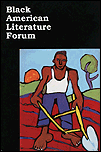
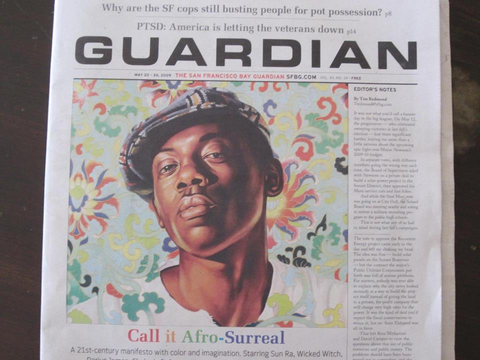
Left: Henry Dumas edition of the Black American Literature Forum
Right: “This Is Afro-surreal” issue of the San Francisco Bay Guardian
expression
1930's - Inspired by the Harlem Renaissance, the Negritude movement emerges in France, led by African and Caribbean students. Artists of all mediums disavow colonialism, racism, and Eurocentrism. (5)
“Afro-surrealism has long existed in one form or another, bubbling away, slowly encroaching, thriving in the margins before occasionally spilling into the centre. The Negritude movement in 1930s France, spearheaded by the likes of Aimé Césaire, Léopold Sédar Senghor, Léon Damas and Aristide Maugé, saw a focus on Africa despite their sense of displacement. Surrealism shared striking commonalities with traditional African art and literature which they drew from to inform a revolutionary politic that included presenting the ‘new black’ whilst aiming to decolonize the country as well as its minds.”
Present - As the social constructs of "race," "ethnicity," "identity," etc. continue to fluctuate, artists express ever-evolving absurdities of lived truth. Afrosurrealism can be found in anything from literature to visual installation to music.
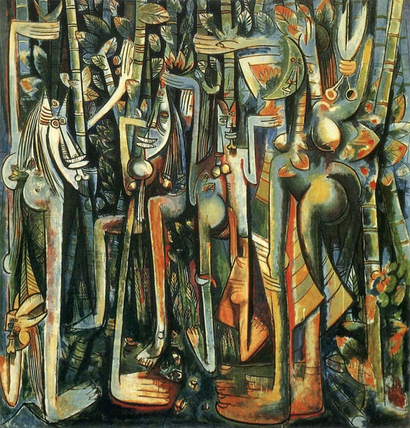
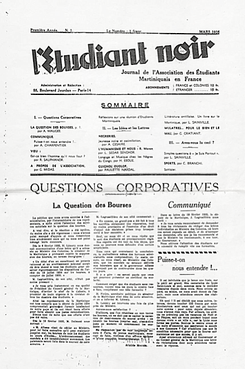
Left: "The Jungla," Wilfredo Lam (1943)
Right: L'edudiant Noir, Negritude movement journal
Philosophy
movement
As D. Scot Miller wrote in the "Afrosurreal Manifesto," "Afro-Surrealists are ambiguous." (4)
Defying classification defines the afrosurrealism movement. Fluidity prevents the movement from getting co-opted and losing its radical power. (6)
At the same time, ambiguity makes it difficult to draw a single line connecting artists and ideas to afrosurrealism.
As a result, it's easier to understand the afrosurrealism movement by understanding what it isn't. As per the "Definition" and "History" sections of this website, afrosurrealism is not surrealism nor is it afrofuturism.
There's clarity to be found in the negative space. Terri Francis writes:
“So varied are the techniques and approaches to surrealism, Afrosurrealism, avant-garde film or experimental film that the only trait they hold in common is their otherness relative to mainstream, commercial or theatrical Hollywood/independent films. Then again, in a certain light, an Afrosurreal light, ordinary entertainment films can look very strange. Afrosurrealism defamiliarizes and conventional black film begins to look unnatural.” (7)
If this is the case, then why do people remember surrealism as a movement in which artists appropriated non-white cultures? Terri Francis offers a theory:
“Since the surrealists were perhaps not overly invested in distinguishing their agenda, all of these artistic movements have blended over time and it would be understandable to carry a vague sense that white experimental artists appropriated black art full stop." (7)
“European surrealism rebelliously embraced ‘blackness’ through a haze of obsessions and misunderstandings stirred up at viewing African or other diasporic masks and objects—and objectified people. Part of the work that Afrosurrealism does, alongside Afromodernism, is then to re-center blackness at the core of surrealism and modernism, not as catalytic matter but as the manifestations of black artists’ own modalities” (7)
In other words, the purpose of afrosurrealism is to provide the imaginative space to clearly see truth, in all its layered complexity and contradiction, to envision possibilities for radical ways of being.
As such, the practice of afrosurrealism becomes as important as (if not more important than) maintaining a theoretical position.

Amiri Baraka speaking at the National Black Political Convention in 1972

Jacques Stephen Alexis with his wife and their daughter at La Fête de l'Humanité in 1950
Historical context further develops the previous ideas. Robin D. G. Kelley contrasts surrealism from the other avant-garde movements:
“Surrealism from the start differed radically from the many ‘avant-gardes’ that preceded it. Post-Impressionism, Futurism, Cubism, Fauvism, and Dada [1919−22, approximately] were focused almost exclusively on art—or, as in Dada, art and antiart—and to a lesser extent on literature. These avant-gardes were not only white and European, but also, with the partial exception of Dada, openly Eurocentric. Surrealists, however, were emphatically anti-Eurocentric. They openly scorned white supremacy, patriotism, religion, colonialism, prudish morality, and respect for the law.” (7)
For Jacques Stephen Alexis, who wrote the manifesto of the Parti Entente Populaire on the subject of the Haitian Marvelous (surrealism), the marvelous is not an escape into some artistic non-reality.
Rather, the artist is to “have a clear consciousness of specific and concrete current problems.” The marvelous or surrealism is in fact an acute awareness of reality, of “the real dramas which confront the masses.” For the artist carries the people, “cultivating more deeply.” (8)
Afrosurrealism maintains a prominent role in social movements across the world by providing a framework for revolt in which activists engage with both intentionally and unknowingly. (9)
artists
damon davis
“I think any problem creates opportunities for creative response and systemic erasure is no different. But it will take more than artistic narratives to correct hundreds of years of erasure (...) Work like this is absolutely about creating new narratives and origin stories. Both to correct the purposeful lack of representation, but also to outright ignore the Western narrative and create new ones.” (10)
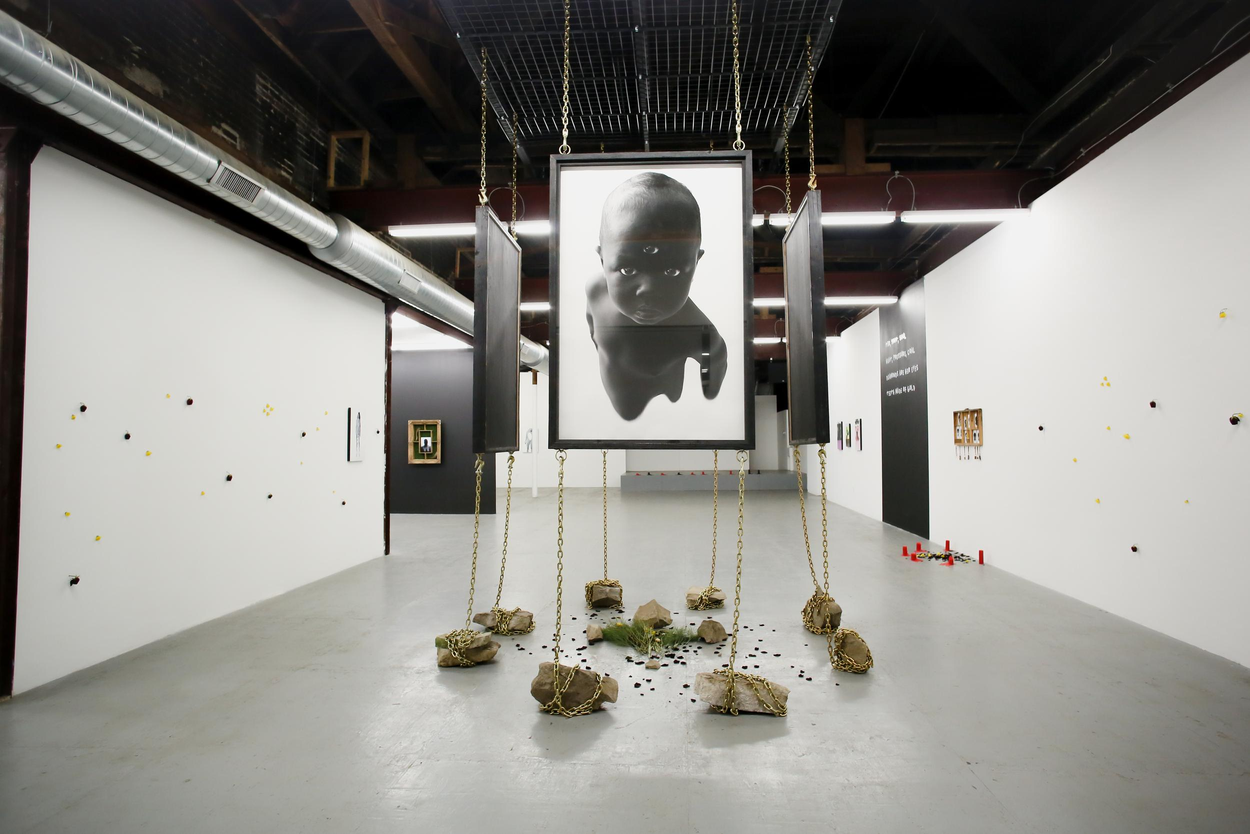
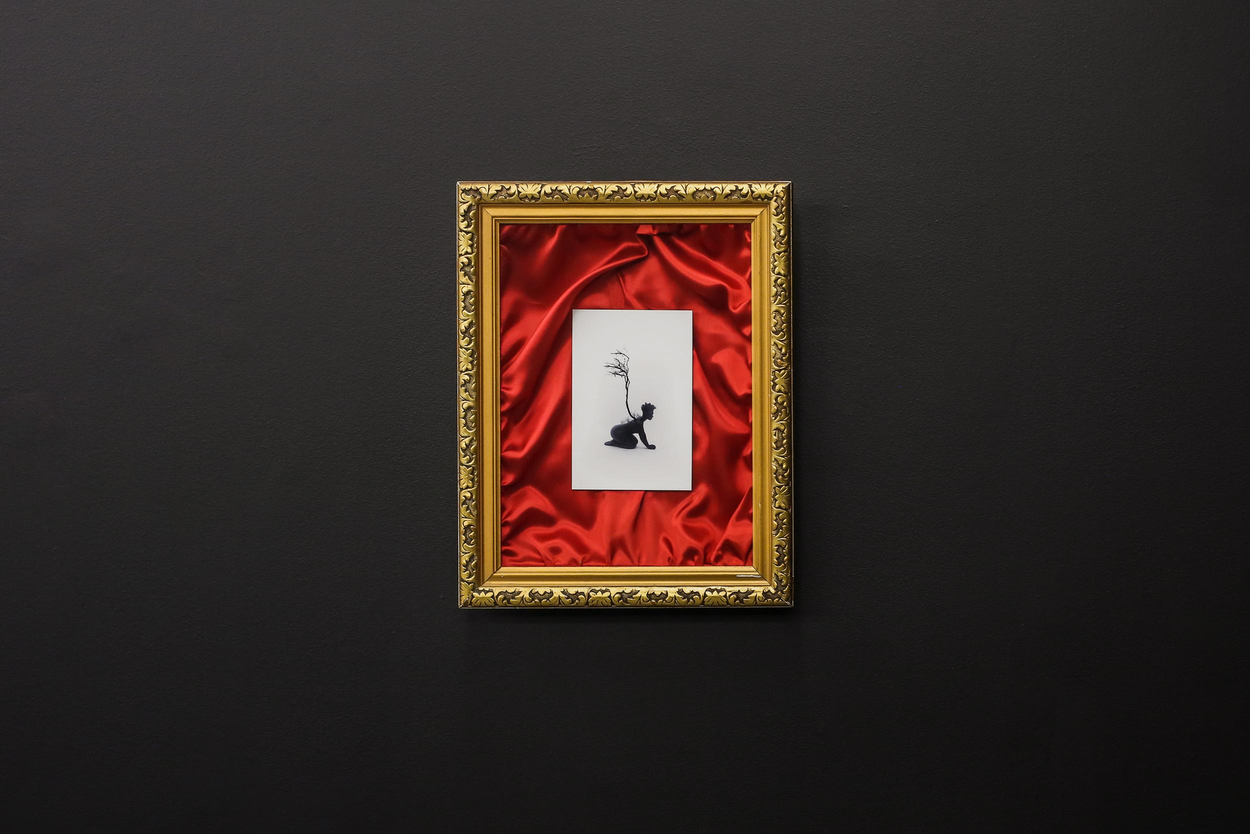
“The Darker Gods in The Garden of Low Hanging Heavens is the introduction to a universe where people of color are divine." (10)
“Darker Gods is a project that began in 2015 when I was interrogating ideas around the black experience in popular culture. I started to think that the representation of Blackness in the United States and the greater Western world was about devaluing the complexity of our experience to make it easier to dehumanize us.
There seems to only be two ways people of color have shown up historically in the collective consciousness: either as sub-human or superhuman, ever complex human beings the way white-identifying people are allowed to be portrayed. As the project grew and evolved, I decided that instead of working hard to show Black people themselves from an empirical, reality-based model, I wanted to lean it the tropes and cultural norms of our experience by exaggerating them to a place of the supernatural and the surreal.” (10)
keerat kaur
“[Art is] a sensory trigger, so it can take you to familiarity while also exposing you to complete novelty.” (11)
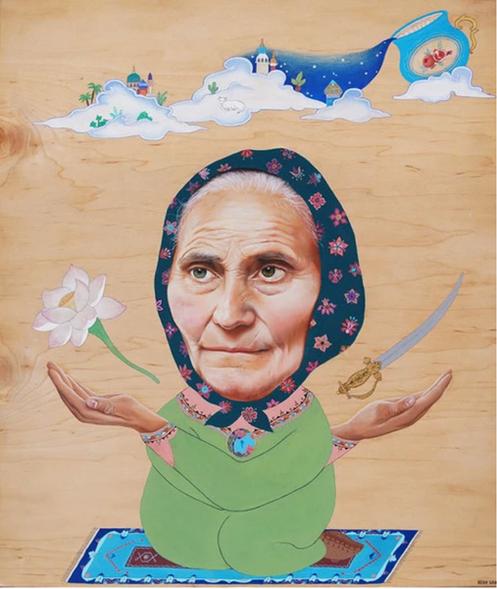
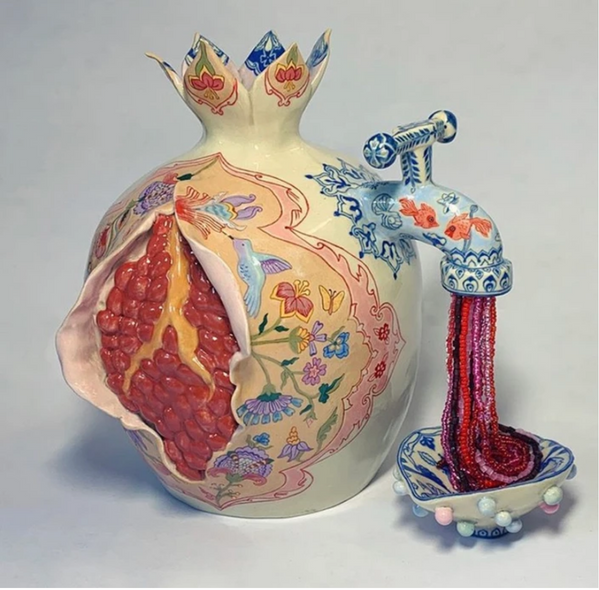
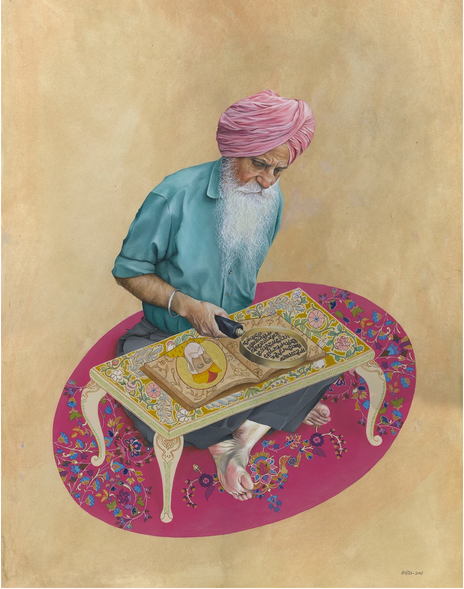
“Sikh literature forms the basis of most of my work, and Punjabi folklore and artisanal crafts are how that work manifests. I give a visual dimension to stories of Sikh history and the poetic devices used to describe it. I give literal, visual representation to those abstract metaphors.” (11)
"In my work, human emotions are felt and represented in the realm of spiritual surrealism, which is both a thematic and stylistic, aesthetic approach. It is a way of using hyper-realistic techniques to portray surrealism and abstract thought, but it’s also a place where you can connect with the otherworldly and connect with things that are not seen and are typically only heard and felt.” (11)
michelle watt
"I often find myself in these liminal thresholds throughout different areas of my life, especially in regards to identity. Being not quite Asian, not quite American, or being a woman wanting to be presentable and look good, but also not wanting to be controlled by it."
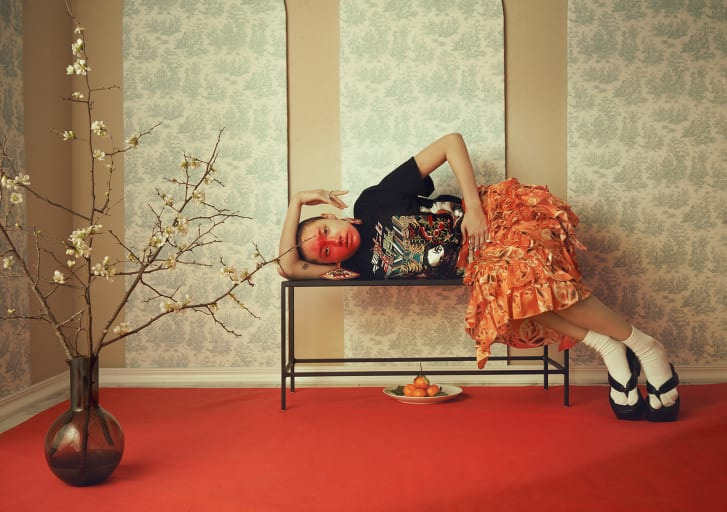
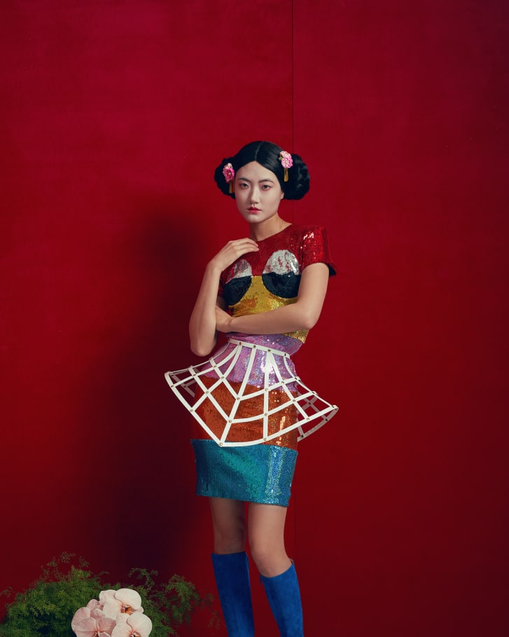
"Her portrait series "Lunar Geisha," published in Blanc Magazine, is an exploration of Asian American female identity. Using the geisha as a metaphor for the hypersexualization of East Asian women, the photos follow the metamorphosis of a young girl from childhood to adolescence to adulthood. In the first image, the girl is playfully sprawled out across a bench, with fruits and white blossoms in the frame conveying innocence. As the girl matures into a young woman in subsequent photos, the use of bold reds evokes menstruation and sexuality.
Watt, who is Chinese American, says the series examines how East Asian women are perceived by society, how they are thrust into playing certain roles, the ways in which they become complicit in those stereotypes and the ways in which they rebel against them." (12)
chila kumari singh burman
"[Burman] went to art school [and wrote] a thesis on Dada and Surrealism as political movements (as opposed to aesthetic movements), before joining a punk band, working on Asian feminist magazine Mukti, and becoming a central figure in the British Black Arts movement in the 1980s." (13)
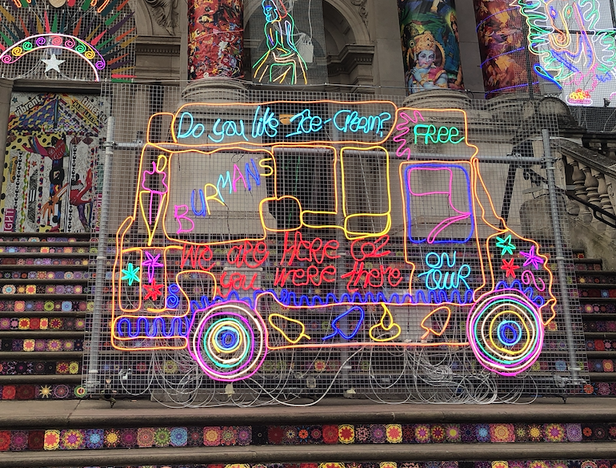
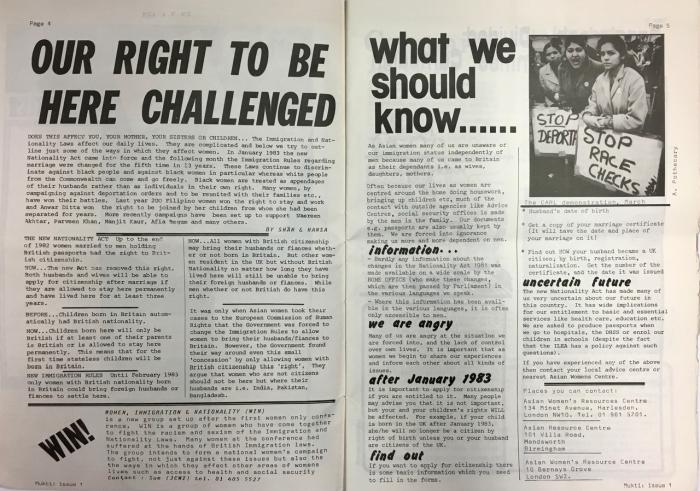
"She draws on fine and pop art imagery in intricate multi-layered works which explore Asian femininity and her personal family history, and where Bollywood bling merges with childhood memories." (14)
donald glover
"It’s that forced relationship to whiteness that gives Atlanta its absurdity — not just the presence of whiteness, but the influence on our spaces. Atlanta is a story of people who already knew these horrifying truths, to the point where they find them predictable, nearly boring." (15)
Watch from 2:43 to 4:45
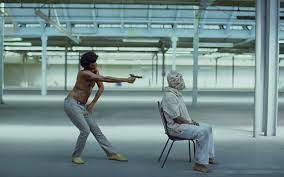
"The theme of whiteness and how it haunts and damns its own recipients becomes almost cartoonishly apparent by the first scene of season three [of Atlanta], later revealed to be a dream within Earn’s (Donald Glover) own dream sequence. Dreams have long been the perfect medium for surrealist art [which] uses discomfiting, contradictory, irrational images to evoke a dream-like state of being. The subconscious takes these images and reorders them, and attempts to make sense of the images’ own reality. Afrosurrealism is, then, a movement that uses these tools to look closely at the already-surreal reality of Black people.
The opening scene features two fishermen at night — one Black and one white — and evokes the terrifying history and folklore behind Georgia’s Lake Lanier, where the government flooded an entire community, including a graveyard, so they could build a lake that would generate power and water supply to surrounding areas. In the eyes and professed experiences of many locals and visitors, Lake Lanier is haunted with ghosts who sometimes appear and drag people underneath the waters. Atlanta’s mock Lake Lanier is built on top of a Black town." (15)
dominique fung
"Asian artifacts and antiques are central to Fung’s art practice. She meditates on the origins and functions of these objects, which are traditionally relegated to the margins of Orientalist paintings." (16)
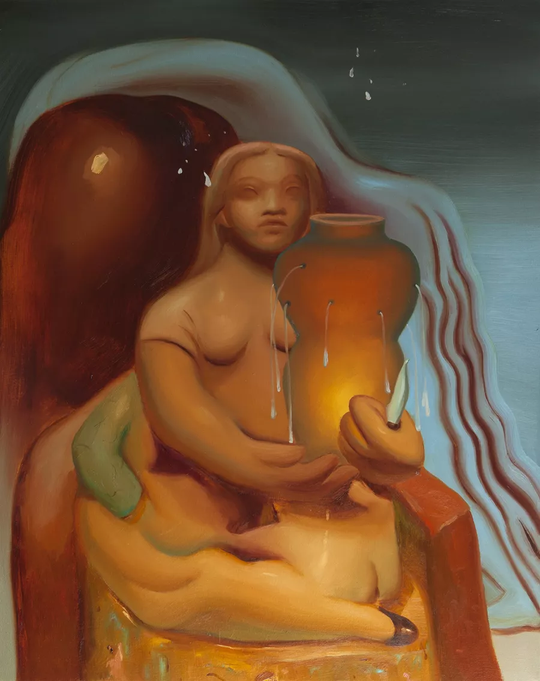
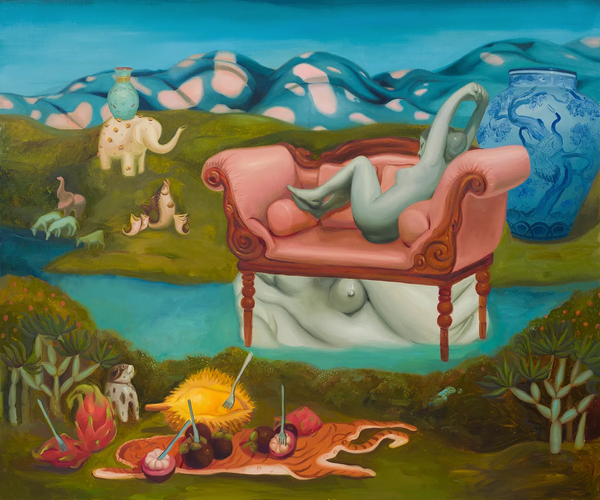
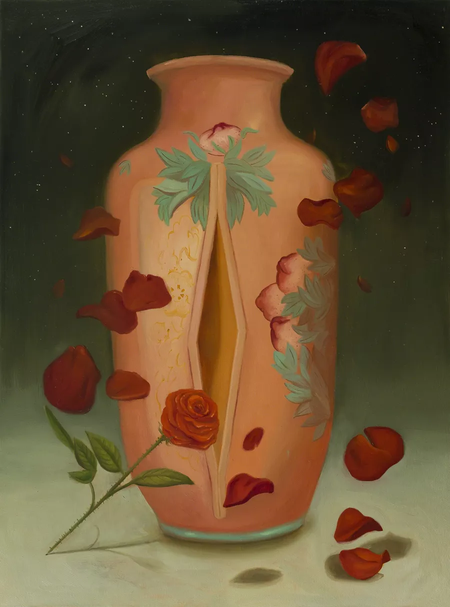
"Fung’s piece recalls Anne Anlin Cheng’s 2018 book Ornamentalism, in which the theorist compares the “yellow woman” to a Ming vase. As Cheng wrote, she is “simultaneously consecrated and desecrated as an inherently aesthetic object.” Cheng coined the term “ornamentalism” to describe the phenomenon in which ornately decorated objects—teapots, vases, and ceramic foo dogs—come to signify yellow skin and flesh. Whereas Edward Said’s Orientalism articulates the Western conception of the East as perpetually inferior and exotic, Cheng’s ornamentalism lays a feminist framework for the yellow woman in particular. Illustrating Cheng’s assertion that the “ornament becomes—is—flesh for Asian American female personhood,” and blurring the distinction between figurative and still life painting, Fung renders the trauma of being fetishized." (16)
tetsuya ishida
"Ishida came of age as an artist during Japan’s 'lost decade,' a period of nationwide economic recession that lasted through the 1990s. His paintings capture the feelings of hopelessness, claustrophobia, and emotional isolation that dominated Japanese society during this time, even—or perhaps especially—in the wake of its rapid technological advancement." (17)
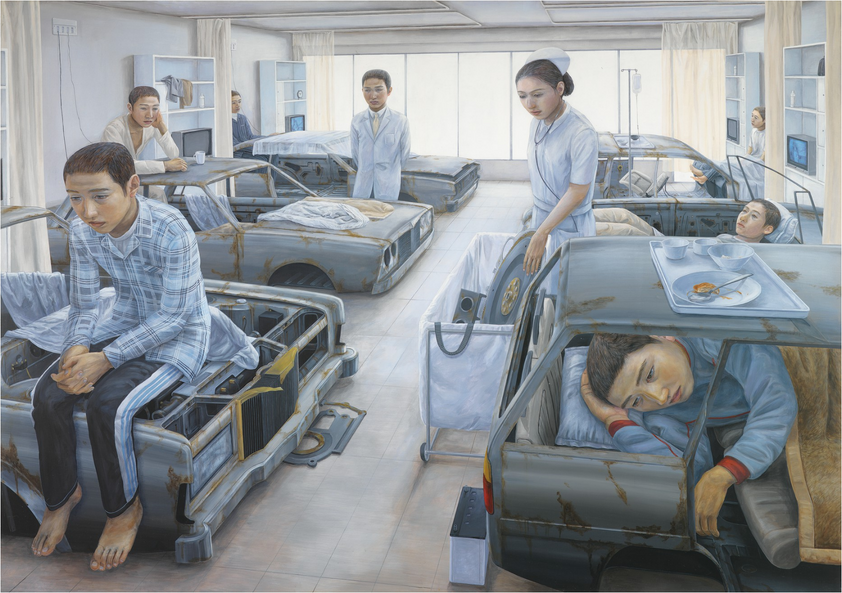
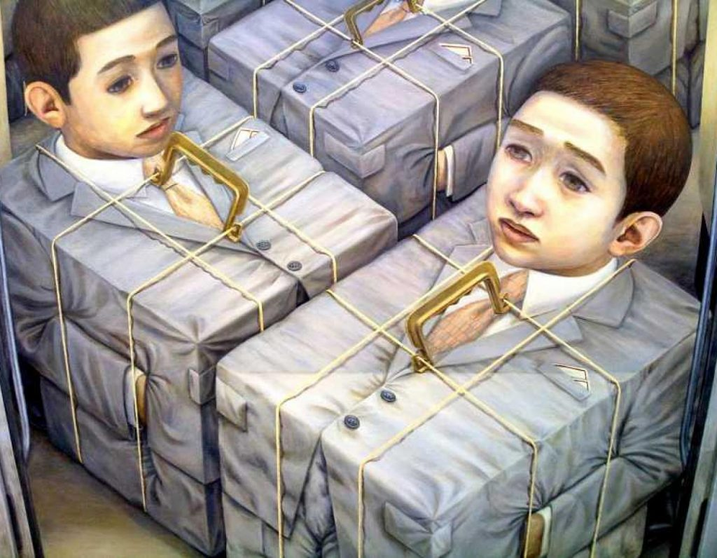
"Often depicting identical-looking students and white-collar “salarymen” fused with machines, buildings, and consumer products, they convey a sense of foreboding and desperation emphasized by a subdued palette of blues and grays.
The unsettling disfigurements endured by his subjects allegorize the pressures placed on Japanese citizens by their country’s changing identity, and by the myriad challenges of integrating new technologies into existing social and professional structures." (17)
shahzia sikander
"Language and geography remain charged notions of inclusion and exclusion, always in flux. Entwined between the linguistic history of English and Urdu, lies the interstice, the narrow space of translation, a metaphor for the colonized, the immigrant and the artist whose job is to locate freedom within confinement.
The multi meaning Urdu phrase, an excerpt from Ghalib’s poetry, is repeated and layered. A play on rote, I was questioning the paradox of learning against the enigma of incompletion. Future resides in overlapping diasporas."
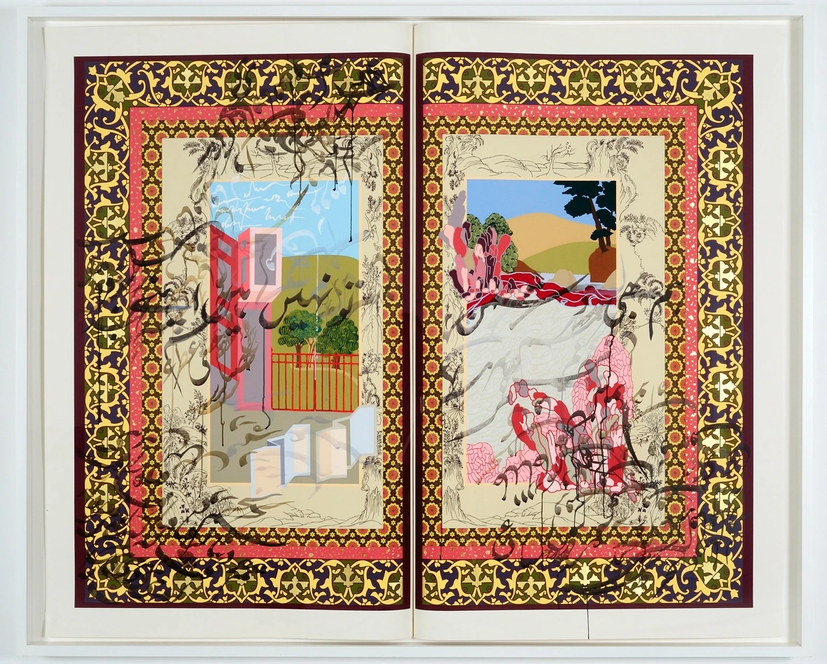
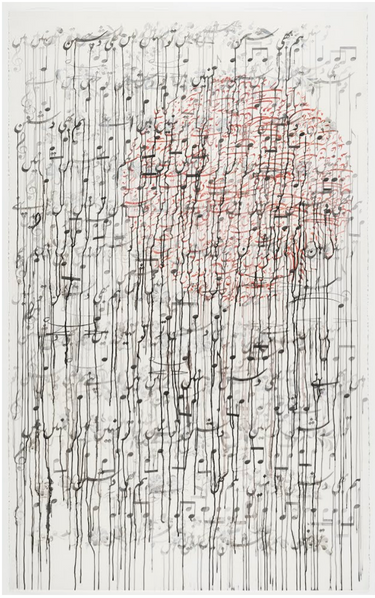
"Imagination is needed to cross boundaries. For me, lack of imagination is literally death.
Because what are we? What is real? When you think in terms of narratives, and how history is determined through narrative, how real is that narrative? The pursuit of truth is so fleeting when it is held hostage to authenticity. Our recent histories are all about redactions, and so everything starts to emerge in a space that is in flux. " (18)
For the first surrealists, bourgeois European culture was tied to the disaster of WWI. Their rejection of white supremacy and Eurocentrism led to a break from traditional European high art practices.
Surrealism has always drawn from African and Asian cultures, particularly through non-European artists in the diaspora.
Despite the inherently anti-imperialist nature of all forms of surrealism, much of the international and multiracial movement has been reduced (in modern eyes) to dead White Europeans "doing weird stuff."
Afrosurrealism is just as interested as early European surrealism in the mind and non-rational knowledge, especially by rejecting the teleology of progress.
Similarly, afrosurrealists are concerned with contradictions between dreams and reality. The magic of afrosurrealism is the artist's focus on revealing the absurdities of reality in order to encourage dreaming better realities. (19)
artists reveal absurd truths through
afro-surrealism
to explore the state of being othered.
References
Definitions
1. https://www.tate.org.uk/art/art-terms/r/realism
2. https://www.tate.org.uk/art/art-terms/s/surrealism
History
3. https://www.jstor.org/stable/2904491
4. https://www.foundsf.org/index.php?title=Afrosurreal_Manifesto
5. https://www.postscript.london/feature/on-afro-surrealism
Philosophy
6. https://i-d.vice.com/en/article/dy8v5w/an-ode-to-afrosurrealism-photography-exhibition-by-adama-jalloh-and-hamed-maiye
7. https://doi.org/10.2979/blackcamera.5.1.95
8. https://doi.org/10.2307/40145043
9. https://amaka.studio/explore/articles/afro-surrealism-the-art-of-resistance
Artists
10. https://heartacheandpaint.com/Darker-Gods-In-The-Garden-of-Low-Hanging-Heavens
11. https://www.thelovepost.global/decolonise-your-mind/articles/interdisciplinary-artist-keerat-kaur-explores-her-sikh-heritage
12. https://www.cnn.com/style/article/michelle-watt-surrealist-photography-cec/index.html
13. https://ocula.com/magazine/art-news/tate-winter-commission-artist-chila-kumari-burman/
14. https://www.artworkersguild.org/membership/find-a-member/burman-chila-kumari-singh/
15. https://www.vox.com/23032541/atlanta-afro-surrealism-donald-glover
16. https://www.artsy.net/article/artsy-editorial-dominique-fung-upends-persisting-fantasies-asian-womanhood-surreal-paintings
17. https://gagosian.com/artists/tetsuya-ishida/
18. https://artsandculture.google.com/story/six-asian-american-artists-our-own-words-the-nelson-atkins-museum-of-art/pgVBUoeDY0Tuiw?hl=en
Thesis
19. https://commonreader.wustl.edu/c/the-non-white-shape-of-things-to-come/